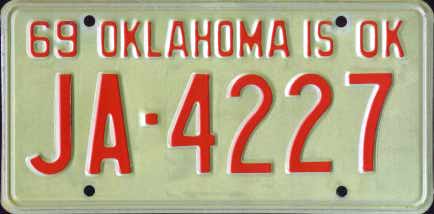 |
Oklahoma 1969 passenger issue. Oklahoma plates from 1969 through 1978 alternated between red-on-white and green-on-white. Plates were issued in an AB-1234 format with the first two letters signifying the county of issue. This plate was issued in Jackson county, which was allocated JA, JK, JS and JX for county codes. |
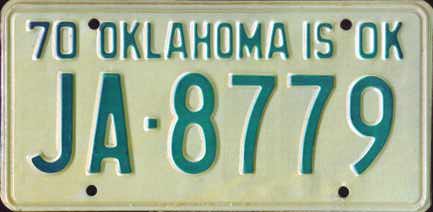 |
Oklahoma 1970 passenger issue. Green on white issue. This plate was also from Jackson county, carrying the same "JA" county code. |
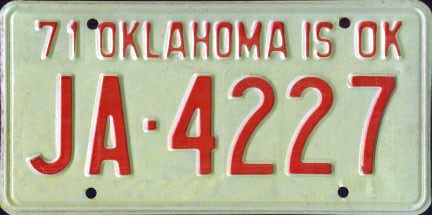 |
Oklahoma 1971 passenger issue. Same colors, county, and plate number as the 1969 plate. Apparently the same number was issued to an owner during subsequent years. Starting with the 1971 issue, some counties overran their allotment of plates and required supplemental seven-digit plates to be made using three-character county codes. As a result, some plates on this base have seven digits and use narrower dies first introduced in 1960. The state switched to the narrow dies for all issues starting in 1976, but plates on the 1971, 72 and 73 bases have two different die sets in use depending on the number of characters on the plate. |
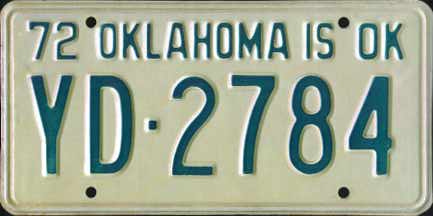 |
Oklahoma 1972 passenger issue. This plate was issued in Oklahoma county, which is one of the larger metropolitan areas of the state (greater Oklahoma City) and had many codes. |
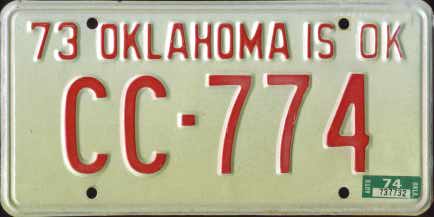 |
Oklahoma 1974 passenger issue (1973 base). This was the first multi-year issue for the state, but not by design. A July, 1973 riot at the Oklahoma State Prison in McAlester resulted in a fire at the prison plate shop, destroying the supply of 1974 dated plates. As a result, the 1973 issues were carried over for a second year with a small "74" sticker applied to the bottom. These plates are hard to find in good condition because they were only designed to last one year and the second year of use in the hot, dry Oklahoma environment tended to do a number on the plates. This issue came from Commanche county. |
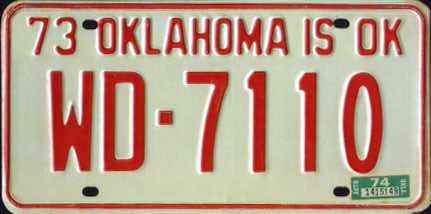 |
Oklahoma 1974 passenger issue (1973 base). This was a base variation of the 1973 base, using different dies and adding a border around the outside of the plate. Plates of this type were manufactured by the Polyvend corporation of Arkansas, using dies and materials similar to those used on Illinois plates of the era. Polyvend got the contract to produce supplemental 1973/74 plates as well as the 1975 series due to the prison's plate shop still being out of commission. This plate was issued in Woods county, which must have been a rather small jurisdiction, only having the "WD" county code. |
 |
Oklahoma 1974 passenger issue (unissued). This plate is a relatively rare example of one of the 1974 passenger plates that was salvaged after the plate shop fire at the Oklahoma State Prison in McAlester. Most "fire survivor" plates show burn marks or other fire damage, with this one being in fairly good shape considering its history. Note that the 1974 issue was manufactured using narrower dies that had been used on Oklahoma plates from 1960 through 1962, as well as on seven-digit plates starting in 1971. |
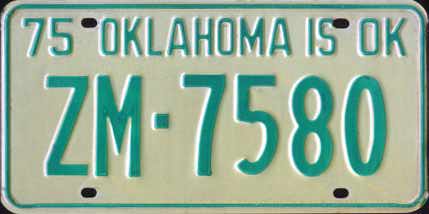 |
Oklahoma 1975 passenger issue. This plate was, again, made out of state by Polyvend while the Oklahoma plate shop was repaired and retooled. It is made of some of the thinnest aluminum I've ever encountered short of Reynolds Aluminum Foil, same as the notoriously thin and flimsy Illinois plates of the time. This plate was also issued in Tulsa county, as were all "Z" prefix plates. |
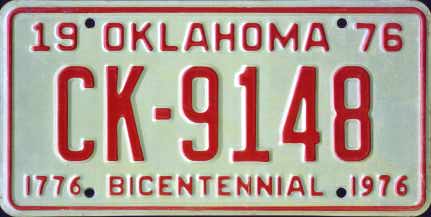 |
Oklahoma 1976 passenger issue. This Bicentennial issue was the first OK plate since 1967 not to include the "is OK" slogan. These plates were once again produced in Oklahoma using the narrow dies that were to have been used on the 1974 plates. These are still in use as of today. This was one of many US state issues to commemorate the Bicentennial year of 1976. This plate was from Creek county, who had CJ, CK, CU and later CKK as county codes. |
 |
Oklahoma 1977 passenger issue. Back to the standard "Oklahoma is OK" issue. This plate was issued in Tulsa county. |
 |
Oklahoma 1978 passenger issue. This was the last of the yearly issues for Oklahoma. This one was an early Tulsa county plate. |
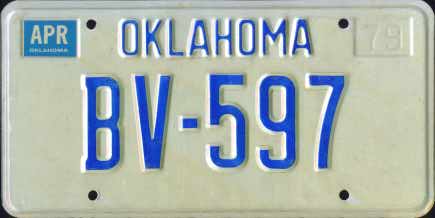 |
Oklahoma 1979 passenger issue. This was the first intentional multi-year Oklahoma base, being used for both 1979 and 1980 with proper validation. There was no 79 sticker, the plate had the year lightly debossed in the top right sticker box. This series carried over the standard county coding that had been in place since 1963. This particular plate was issued in Beaver county, another small jurisdiction with one code (BV). This series was issued through 1980 and again did not include the "is OK" slogan. |
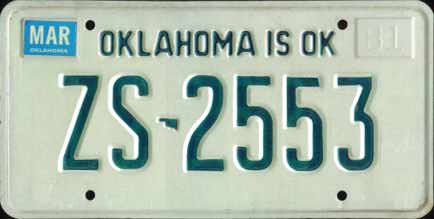 |
Oklahoma 1981 passenger issue. The state returned to green on white and the "is OK" slogan in 1981 when these baseplates were first issued. These were issued through the end of 1982, and again had the year lightly debossed in the top right sticker box. This base marked the last general re-issue for the state prior to 2009. Plates of this era could therefore still be seen in use through December, 2009 with proper stickers. This plate was the first to use the state-shaped divider between numbers and letters. |
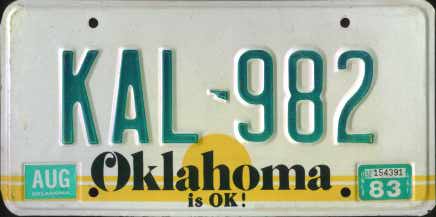 |
Oklahoma 1983 passenger issue. These "sunbelt" graphic plates were first issued in 1982 and could still be used through the end of 2009. These plates used an ABC-123 format and were again issued by county, although new coding was used. This plate was issued in Kay county. |
 |
Oklahoma 1990 passenger issue. This graphic motif contains several different symbolic elements related to Oklahoma's native heritage, as explained to me by Oklahoma resident John Kerestes: "The tan circle is the battle shield of the Osage Nation. The calumet and olive branch represents the unity of Native Americans and white settlers. The four white crosses (there are really 5, but one is hidden) are actually *stars* to Indians. They represent the Five Civilized Tribes that were forced here under Pres. Jackson's command. They are the Cherokee, Chickasaw, Choctaw, Creek, and Seminole. Last, the 7 feathers represent the first seven counties of Oklahoma Territory which were once a part of the Unassigned Lands prior to the first of five Land Runs in 1889. The first seven counties are Canadian, Cleveland, Kingfisher, Lincoln, Logan, Oklahoma, and Payne." Thanks again for the enlightening information, John. These plates were introduced in 1989 and issued through the end of 1993. The plate shared the ALPCA Plate of the Year award in 1989 with Nova Scotia. This graphic was modified for the next base in 1994. |
 |
Oklahoma 1994 passenger issue. Later issues on this base used a slightly different background sheeting. The biggest difference between the two is the size of the state name, which is printed smaller on this version. There are also slight differences to the graphic at center. This plate shows a pronounced debossed area in the center as well, which has carried over ever since. |
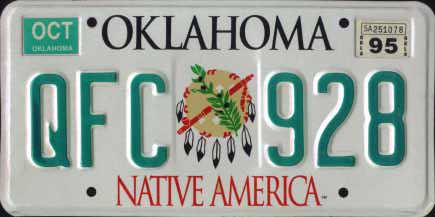 |
Oklahoma 1995 passenger issue. This is the current Oklahoma base, featuring a redrawn graphic, new typeface for the state name, and new "Native America" slogan. The fifth white cross in the graphic is hidden on this issue, as stated by John above. The first issue of this plate design actually did show all five. This plate, starting with a "Q" character, was issued in Oklahoma county (greater Oklahoma City). |
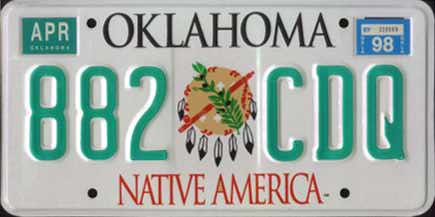 |
Oklahoma 1998 passenger issue. Same issue as above, but some counties with higher number of registrations are now issuing plates in a reversed 123-ABC format. This plate was such a reverse-format plate from Comanche county. |
 |
Oklahoma 2006 passenger issue. Oklahoma has recently adopted a revised, larger die set, as seen on this plate. The newer characters are approximately 1/8" taller than the old set, with the characters also being slightly wider and more squared-off (check out the shapes of the '0', '8', 'O' and 'Q' characters for examples.) |
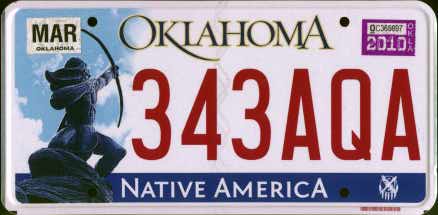 |
Oklahoma 2010 passenger issue. Oklahoma began its first general plate reissue since 1978 in January, 2009. This new graphic features an image of a Native American archer against a blue sky to the left of the plate, also retaining the "Native America" slogan and crest from the previous plate at bottom. These plates are issued in a non-county-coded format, starting in the AAA series, presumably skipping previously-issued sequences in the 123-ABC format. Plates are produced with 3M's digital plate technology and are flat, using the same serial font as many other states' flat plates. |
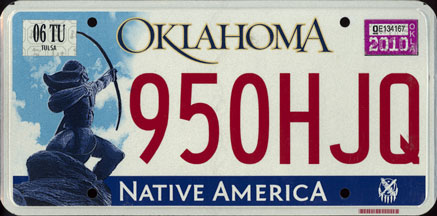 |
Oklahoma 2010 passenger issue. Continuation of the 2009 base above, starting in 2010 some counties started using a modified month sticker including the county of issue (06 TU in this case indicating a June expiration and Tulsa county.) This was to address concerns over the loss of long-standing county coding on Oklahoma plates, restoring the ability to decode the county of issue by looking at the plate. Existing registrations are issued these new stickers on renewal, so presumably all plates on this base ended up with this sticker design before being replaced in 2017. |
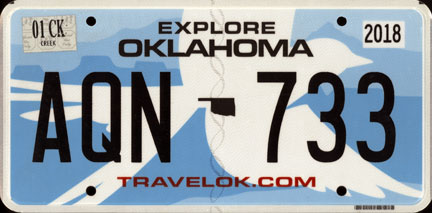 |
Oklahoma 2017/2018 passenger issues. Oklahoma introduced a new plate in 2017 which is slated to replace all existing sacred arrow bases by the end of the year. The new design features a blue landscape with a large white scissor-tailed flycatcher in the foreground. The new slogan "Explore Oklahoma" is included at top, with the state's tourism website listed at bottom. Serial format has been reversed to an ABC-123 sequence with a state-shaped separator included. Reaction to this plate has been mixed, they're a bit hard to read at a distance and the background resembles the Twitter logo more than anything else.
Oklahoma's registration system allows motorists to choose any expiration month, resulting in some of these plates being backdated to 2017 expirations. Of course, all these 2017 expirations needed 2018 stickers upon renewal, resulting in both screened and stickered 2018 expirations. |
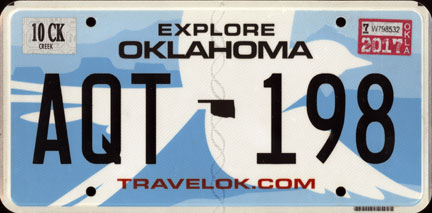 |
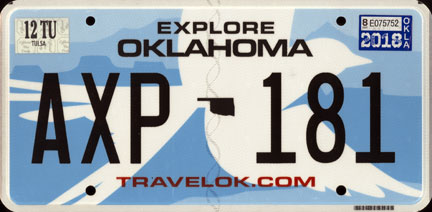 |
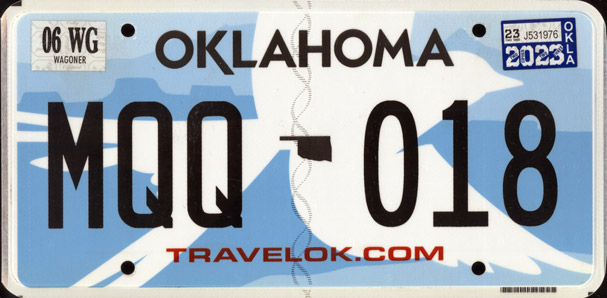 |
Oklahoma 2023 passenger issue. In 2022, a design tweak was made to the Oklahoma Twitter plate, replacing the state name and Explore slogan with just a new stylized state name. The state tourism website remains at bottom on the off chance you'd still like to explore Oklahoma. This change took place in the late L series. |
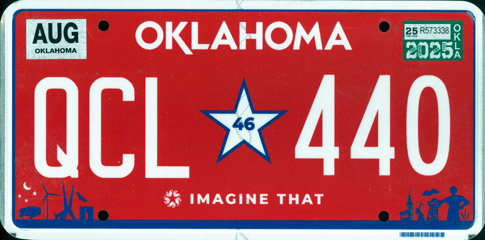 |
Oklahoma 2025 passenger issue. A new general issue was rolled out starting in 2024 in Oklahoma, featuring a red background, star with the number 46 in it (referencing Oklahoma's position as the 46th state admitted to the union) and the state's current tourism slogan Imagine That at the bottom along with some skyline, wildlife and Native American imagery in the corners. This plate derived from a previous optional issue including a similar star motif and the state slogan "Labor Omnia Vincit," which does not translate to "Imagine That." |
| 2025 Update: As of the end of May, 2025, Oklahoma is issuing new Imagine That plates to all new registrants and renewals. These should replace all prior issues by the end of the year. |


























